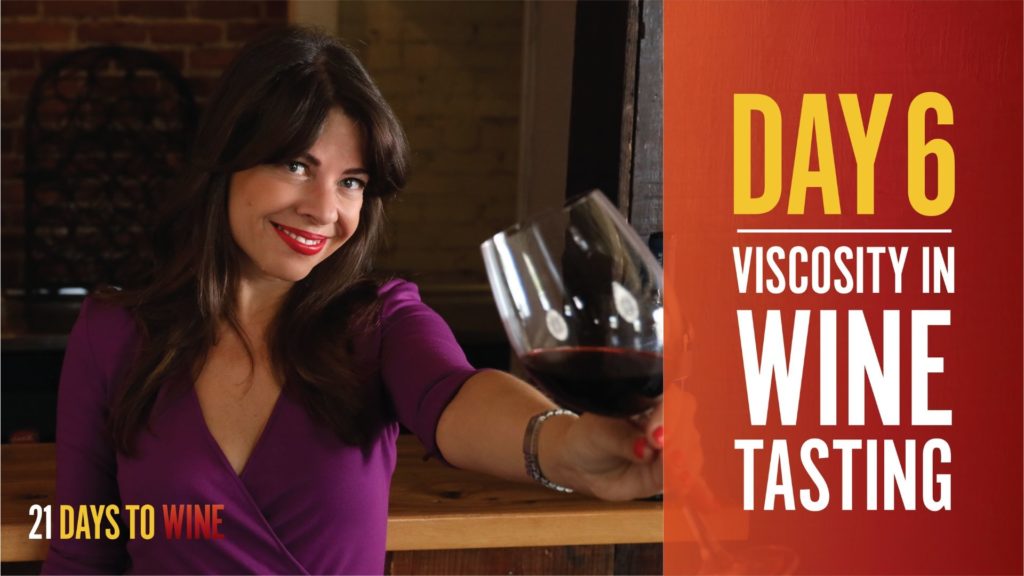DiVino may earn commissions from qualifying purchases.
And we’re back!
Ever wonder what gives your wine its legs? DAY 6 is here and it’s all about viscosity.
WATCH on Youtube.
Remember, that subscription to the YouTube channel and DiVino Wine School enrollment are free!
Enrollment comes with full access to downloadable DiVino Wine School class notes directly from this website!
Wine of the Day
Cantele Primitivo 2016
Find a Primitivo online.
FOLLOW ALONG!
Drink wine along with me, Annie, and learn to engage all of your senses in a powerful new way. SUBSCRIBE to the channel to follow along.
Stay updated when you enroll in DiVino Wine School. You’ll have full access to class notes from every episode available to download directly from our site. ENROLL TODAY!
Video Transcript
Hi everyone!
Today we’re going to talk about something you can do right now to learn more about wine tasting, even if you don’t have any wine… intrigued? “Stick” around because today is all about viscosity.
Welcome back to day 6 of Divino Wine School!
I’m Annie, certified sommelier, and today we continue our VISUAL evaluation of wine, and specifically the consistency of the wine itself. How it moves in the glass.
TITLE/SCREEN: Day 6 – Viscosity in Wine Tasting
Broll – wine splashing around (stock?)
As usual we have a scent note of the day to train our noses and today is dried fruit, specifically dried cranberries and other mixed berries.
You know you can get a heads up on what we’re smelling and tasting if you click the ENROLL button down below in the description. You’ll also get a copy of the class notes from every episode.
I brought a Primitivo today. This wine comes from the hot and sunny [bootheel // or south ]of Italy and it is packed with hot, juicy dried fruit aromas.
If you haven’t already, pour yourself a small glass of wine. If you’ve got your berries, see if you can smell them in there!
Let me know in the comments if you did.
I would tell you to look and not touch, but there’s no way I can enforce that rule from inside the screen.
This is not the ring. I can’t jump out there and stop you….
But seriously, if you take away anything from this series, it is that wine tasting is truly a multisensory activity. That is why people get obsessed with wine. It activates so many parts of your brain and awakens emotions.
Wine tasting awakens the senses.
It’s no wonder that throughout history, wine has always been a social and religious ritual.
I mentioned in the last few episodes that dense color usually mean darker, richer, riper fruit and spice aromas and flavors and will likely feel denser, silkier or heavier on your palate.
This goes for sparkling wines too. If a sparkling wine is a deeper golden yellow color, expect extra intensity all around and a softer fizz.
Viscosity
But today I want to talk specifically about viscosity.
Gently swirl your glass and watch it cling to the edges and slowly drip down in little arches – those are called tears – and they tell you a lot. Does the wine wash over the glass like water, or cling to it like maple syrup, or something in between?
Does the wine cling to the edges of the glass or wash away?
When I said I didn’t need wine earlier It’s because you can test the viscosity of anything in a glass. Water, juice, you name it! Grab what you’ve got!
Those little arches indicate Glycerol, which is the third most important byproduct of winemaking, after alcohol and C02. There’s more science for you!
Legs on the glass indicate the presence of Glycerol.
While the scientists are still arguing over exactly what causes it during the winemaking process, they all agree that the ripeness of the grapes is a factor.
Ripe, juicy grapes means more sugar, body and more aroma.
Ripe, juicy grapes means more sugar, body and more aroma
More sugar translates to more alcohol and heat.
If a wine glides and glistens on the glass you can bet it will feel the same way in your mouth. Silky, smooth, and warm, whereas a wine that swishes more like water is likely to be lighter and crisp. In the glass and on your palate.
Again, just like color, the consistency of wine depends as much on the grape variety as it does on the climate and the winemaking process.
Consistency depends as much on grape variety and climate as it does on winemaking technique.
The Primitivo today, comes from a hot and sunny climate and the grapes are picked at peak ripeness, for the most part. Look at the way it really holds on to the edges.

This wine is pretty robust. It’s 13.5% alcohol by volume.
If you haven’t already, give your glass a swirl, not too hard, and watch how it behaves.
Swirl gently.
Can you make a few assumptions about how it will smell, feel, and taste? Take a sip an see if you were close. Let me know in the comments below.
Don’t forget to subscribe and enroll to take full advantage our series.
See you next time!
Cheers!



